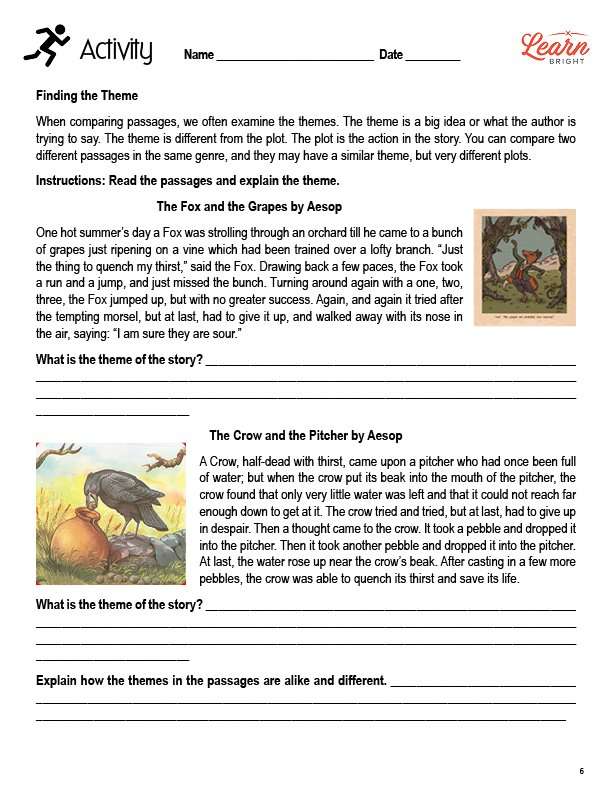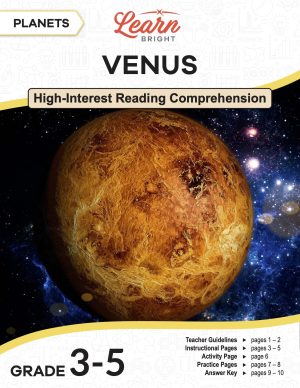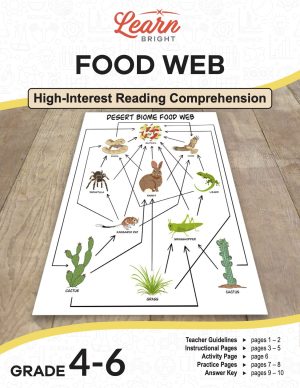Description
What our Compare/Contrast Stories – Same Genre lesson plan includes
Lesson Objectives and Overview: Compare/Contrast Stories – Same Genre teaches students how to effectively compare and contrast two stories from the same genre. At the end of the lesson, students will be able to identify the theme of a story, compare and contrast an author’s approach to theme and topic in stories with the same genre, and understand that stories may have the same theme or topic even though story elements differ. This lesson is for students in 5th grade.
Classroom Procedure
Every lesson plan provides you with a classroom procedure page that outlines a step-by-step guide to follow. You do not have to follow the guide exactly. The guide helps you organize the lesson and details when to hand out worksheets. It also lists information in the yellow box that you might find useful. You will find the lesson objectives, state standards, and number of class sessions the lesson should take to complete in this area. In addition, it describes the supplies you will need as well as what and how you need to prepare beforehand. The only supplies you will need for this lesson are the handouts; to prepare for this lesson ahead of time, you can copy the handouts.
Options for Lesson
Included with this lesson is an “Options for Lesson” section that lists a number of suggestions for activities to add to the lesson or substitutions for the ones already in the lesson. This section notes that some students may find the words included in the homework assignment challenging; if you think this might be the case with your students, one option is to preview the homework assignment in class. An addition to this lesson could be to have students create a list of theme words for comparison.
Teacher Notes
The teacher notes page includes a paragraph with additional guidelines and things to think about as you begin to plan your lesson. It notes that students may have difficulty distinguishing the theme of a story from the plot of the story, so it’s a good idea to pay close attention to that. This page also includes lines that you can use to add your own notes as you’re preparing for this lesson.
COMPARE/CONTRAST STORIES – SAME GENRE LESSON PLAN CONTENT PAGES
Compare Two Stories or Genres
The Compare/Contrast Stories – Same Genre lesson plan includes three pages of content. The lesson begins with an explanation of what a genre actually is. A genre is a category or type of literature. Some genres includes fiction, nonfiction, poetry, drama, and prose. We can compare and contrast stories from different genres. We can do this by looking at things like setting, character, theme, or purpose.
The lesson asks students to read two passages — one titled Uncle Ned, one titled Samuel Barton — and complete a provided Venn Diagram to compare and contrast them. The Uncle Ned passage describes the author’s uncle, who grew up taking pictures of the wildlife near his family’s farm. He inherited the farm and continued being a nature photographer. The Samuel Barton passage describes a patriot and pioneer named Samuel Barton, who was a hunter in Tennessee. He became a Sergeant in the American Revolution, and became a land trader after the war.
Students will answer some additional questions about the passages. One of these questions includes a sentence from one of the passages and asks them to determine what the word “acclaim” means in that sentence. They must then answer questions that ask them what Samuel Barton was acclaimed for and if Uncle Ned was acclaimed for the same thing. They must then explain their answer.
COMPARE/CONTRAST STORIES – SAME GENRE LESSON PLAN WORKSHEETS
The Compare/Contrast Stories – Same Genre lesson plan includes three worksheets: an activity worksheet, a practice worksheet, and a homework assignment. You can refer to the guide on the classroom procedure page to determine when to hand out each worksheet.
FINDING THE THEME ACTIVITY WORKSHEET
Students will compare the themes in two different passage for the activity worksheet. Themes are the big ideas of a piece of writing, which is different from the plot. Plot is the action of a story. For this activity, students will read two passages and explain the themes of each. They will then explain how the themes in the passages are alike and different.
Students may work either alone or in groups for this activity if you’d prefer.
COMPARE AND CONTRAST PRACTICE WORKSHEET
The practice worksheet asks students to first read two passages. They will then determine what the common theme of both passages is. Next, they will use a provided graph to compare and contrast the themes of the passages.
COMPARE/CONTRAST STORIES – SAME GENRE HOMEWORK ASSIGNMENT
For the homework assignment, students will first read a list of words and determine whether each describes or sounds like a theme or not. There are 12 words. Next, they will read a short story and explain the theme.
Worksheet Answer Keys
This lesson plan includes answer keys for the activity worksheet, the practice worksheet, and the homework assignment. If you choose to administer the lesson pages to your students via PDF, you will need to save a new file that omits these pages. Otherwise, you can simply print out the applicable pages and keep these as reference for yourself when grading assignments.









